Study on the Influence of Laser Power on the Heat–Flow Multi-Field Coupling of Laser Cladding Incoloy 926 on Stainless Steel Surface
Abstract
:1. Introduction
2. Materials and Experimental Methods
3. Laser Cladding Theory Modeling and Solving
- (1)
- The laser energy is assumed to obey a Gaussian distribution, and the heat input is stabilized, which acts directly on the surface of the molten pool.
- (2)
- The powder stream concentration is assumed to obey a Gaussian distribution, and it melts immediately after falling into the melt pool.
- (3)
- The metal melt is assumed to be an incompressible Newtonian fluid, and the flow inside the molten pool is laminar.
- (4)
- The thermophysical parameters of the substrate and the powder are assumed to be temperature dependent and to exhibit isotropy.
- (5)
- The effect of carrier and protective gases on the melt pool is assumed to be neglected.
3.1. General Control Equations for Laser Cladding
3.2. Initial and Boundary Conditions for Numerical Solution
3.3. Numerical Modeling and Parameter Settings
4. Analysis of Numerical Simulation Results
4.1. Analysis of Temperature Field
4.2. Analysis of the Velocity Flow Field
4.3. Analysis of Melt Pool Morphology
4.4. Analysis of Solidification Characteristics
5. Experimental Verification of Laser Cladding Incoloy 926 on 316L Surface
5.1. Analysis of the Macroscopic Morphology of the Cladding Layer
5.2. Analysis of the Microstructure of the Cladding Layer
5.3. Analysis of the Elemental Distribution of the Cladding Layer
6. Conclusions
- (1)
- In the process of laser cladding, the molten pool is elliptically distributed and exhibits a symmetrical Marangoni flow inside. With the increase in laser power, the peak temperature and velocity of the molten pool surface increase gradually, which promotes the further expansion of the width and length of the molten pool. Both of them have the same trend in the axial direction. The thermal influence of the molten pool center on the edge increases gradually, especially the depth of the molten pool.
- (2)
- When the laser power increases, the temperature gradient, solidification rate, and cooling rate of the molten pool gradually increase. While the microstructure parameters (G/R) are relatively small when the laser power is 1000 W.
- (3)
- In the test range of laser cladding Incoloy 926 on 316L surface, with the increase in laser power, the dilution rate and wetting angle of the cladding layer both increase. When the laser power is 1000 W, the elements inside the cladding layer are more evenly distributed and the microstructure is finer. The experimental and simulated results agree well with each other.
Author Contributions
Funding
Institutional Review Board Statement
Informed Consent Statement
Data Availability Statement
Conflicts of Interest
References
- Yan, X.C.; Chang, C.; Deng, Z.Y.; Lu, B.W.; Chu, Q.K. Microstructure, interface characteristics and tribological properties of laser cladded NiCrBSi-WC coatings on PH 13-8 Mo steel. Tribol. Int. 2021, 157, 106873. [Google Scholar] [CrossRef]
- Jin, J.Y.; Li, F.R.; Zheng, C.Q.; Li, H.; Wu, M.F. Structure and properties of laser-cladded Ni-based amorphous composite coatings. Mater. Sci. Technol. 2016, 32, 1206–1211. [Google Scholar] [CrossRef]
- Ullah, Z.A.; Yasir, M.K.; Ehtsham, R.U.; Sibghat, U.; Muhammad, A. A review on laser cladding of high-entropy alloys, their recent trends and potential applications. J. Manuf. Process. 2021, 68, 225–273. [Google Scholar] [CrossRef]
- Na, G.; Luai, T.M.; Jing, C.; Yong, W.; Rahul, K. Laser-cladding of high entropy alloy coatings: An overview. Mater. Technol. 2023, 38, 2151696. [Google Scholar] [CrossRef]
- Zhu, L.D.; Xue, P.S.; Lan, Q.; Meng, G.R.; Ren, Y. Recent research and development status of laser cladding: A review. Opt. Laser Technol. 2021, 138, 106915. [Google Scholar] [CrossRef]
- Takeru, S.; Osamu, U. High-strength and high-toughness austenitic stainless steels based on type 316LN at 4.2 K. Cryogenics 2023, 136, 103762. [Google Scholar] [CrossRef]
- Yang, Z.; Qu, W.; Cai, W.; Shi, S.; Yu, Z.; Zhao, Y.; Xu, Y.; Li, W. Research on the mechanism and process optimization of pulsed laser descaling of Q235 steel for offshore equipment. AIP Adv. 2024, 14, 045127. [Google Scholar] [CrossRef]
- Timothy, P.; Yu, H.; Judith, V.; Augustine, C.; Yu, Z. Stress relaxation cracking susceptibility evaluation in 347H stainless steel welds. Weld. World 2024, 68, 657–667. [Google Scholar] [CrossRef]
- Ding, T.; Zhang, Y.; Li, J.; Liu, J.; Liu, Y. Research status and prospect of laser cladding technology for stainless steel surface. Met. Heat Treat. 2022, 47, 205–212. [Google Scholar] [CrossRef]
- Rao, S.B.; Venkadeshwaran, K.; Shivaprasad, Y.N. Research and Development Status of Laser Cladding on Stainless Steel Alloys: A Review. Mater. Sci. Forum 2023, 1110, 35–54. [Google Scholar] [CrossRef]
- Zhou, Z.J.; Du, Y.B.; He, G.H.; XU, L.; Shu, L.S. Optimization and Characterization of Laser Cladding of 15-5PH Coating on 20Cr13 Stainless Steel. J. Mater. Eng. Perform. 2022, 32, 962–977. [Google Scholar] [CrossRef]
- Li, G.; Wang, Z.; Yao, L.; Xie, D.Z.; Chen, G. Concentration mixing and melt pool solidification behavior during the magnetic field assisted laser cladding of Fe-Cr-based alloy on 45 steel surface. Surf. Coat. Technol. 2022, 445, 128732. [Google Scholar] [CrossRef]
- Wang, X.; Zhang, Z.; Zhao, Y.; Hu, Z.Q.; Li, X. Macroscopic morphology and properties of cobalt-based laser cladding layers on rail steel based on pulse shaping. Opt. Laser Technol. 2024, 168, 109940. [Google Scholar] [CrossRef]
- Nie, M.; Zhang, S.; Wang, Z.; Zhang, C.; Chen, H.; Chen, J. Effect of laser power on microstructure and interfacial bonding strength of laser cladding 17-4PH stainless steel coatings. Mater. Chem. Phys. 2022, 275, 125236. [Google Scholar] [CrossRef]
- Qian, S.X.; Dai, Y.B.; Guo, Y.H.; Zhang, Y.K. Microstructure and Wear Resistance of Multi-Layer Ni-Based Alloy Cladding Coating on 316L SS under Different Laser Power. Materials 2021, 14, 781. [Google Scholar] [CrossRef]
- Figueredo, A.W.E.; Apolinario, R.H.L.; Santos, V.M.; Silva, A.C.S.; Avila, J.A. Influence of Laser Beam Power and Scanning Speed on the Macrostructural Characteristics of AISI 316L and AISI 431 Stainless Steel Depositions Produced by Laser Cladding Process. J. Mater. Eng. Perform. 2021, 30, 3298–3312. [Google Scholar] [CrossRef]
- Rivero, S.H.E.L.; Pizzatto, A.; Teixeira, F.M.; Rabelo, A.; Falcade, T. Effect of Laser Power and Substrate on the Hastelloy C276TM Coatings Features Deposited by Laser Cladding. Mater. Res. 2020, 23, e20200067. [Google Scholar] [CrossRef]
- Zhu, S.C.; Niu, B.L.; Chang, Z.; Jiang, Z.Y.; Deng, Z.H. Research on heat and mass transfer in the molten pool of laser cladding. Int. J. Adv. Manuf. Technol. 2024, 132, 983–1004. [Google Scholar] [CrossRef]
- Mahmoud, A.; Ghadimi, H.H.; Nima, M.; Morteza, Y.; Mahdi, H. Investigating the effect of laser cladding parameters on the microstructure, geometry and temperature changes of Inconel 718 superalloy using the numerical and experimental procedures. Mater. Today Commun. 2023, 35, 106329. [Google Scholar] [CrossRef]
- Li, Y.; Pan, Z.; Qi, X.; Cui, W.Q.; Chen, J. Influence law of heat treatment process on temperature field and stress field of laser clad 316L. China Mech. Eng. 2024, 35, 666–677. [Google Scholar]
- Li, G.; Wang, Z.; Yao, L. Component mixing, fluid flow and cooling rate in laser cladding of Fe-Cr-based alloys on 45 steel. Optik 2023, 272, 170318. [Google Scholar] [CrossRef]
- Feng, W.; Wang, T.; Gu, Z.; Zhang, X.; Yao, T. Numerical simulation and analysis of melt pool evolution on laser polished 316L stainless steel surface. Optoelectron.-Laser 2024, 3, 1–10. [Google Scholar]
- Si, B.S.; Thomas, C.; Yann, Q.; Wilfired, p.; Srikanth, N. Integrated approach to stainless steel 316L parts repair for pitting corrosion using laser metal deposition. J. Manuf. Process. 2023, 95, 1–13. [Google Scholar] [CrossRef]
- He, X.; Song, L.; Yu, G.; Mazumder, J. Solute transport and composition profile during direct metal deposition with coaxial powder injection. Appl. Surf. Sci. 2011, 258, 898–907. [Google Scholar] [CrossRef]
- Yong, Y.; Fu, W.; Deng, Q.; Chen, D.B. A comparative study of vision detection and numerical simulation for laser cladding of nickel-based alloy. J. Manuf. Process. 2017, 28, 364–372. [Google Scholar] [CrossRef]
- Chen, L.; Yu, T.; Xu, P.; Zhang, B. In-situ NbC reinforced Fe-based coating by laser cladding: Simulation and experiment. Surf. Coat. Technol. 2021, 412, 127027. [Google Scholar] [CrossRef]
- Khattari, Y.; Rhafiki, E.T.; Choab, N.; Kousksou, T.; Alaphilippe, M. Apparent heat capacity method to investigate heat transfer in a composite phase change material. J. Energy Storage 2020, 28, 101239. [Google Scholar] [CrossRef]
- Guo, Z.; Wang, L.; Wang, C.; Ding, X.Y.; Liu, J.C. Heat Transfer, Molten Pool Flow Micro-Simulation, and Experimental Research on Molybdenum Alloys Fabricated via Selective Laser Melting. Materials 2020, 14, 75. [Google Scholar] [CrossRef] [PubMed]
- Liu, C.; Li, C.; Zhang, Z.; Sun, S.; Zeng, M. Modeling of thermal behavior and microstructure evolution during laser cladding of AlSi10Mg alloys. Opt. Laser Technol. 2020, 123, 105926. [Google Scholar] [CrossRef]
- Li, C.; Zhang, M.; Sun, Y.; Han, X. Research on the Thermal Fatigue Mechanism of Laser Cladding IN625 Process on Ductile Iron. Int. J. Met. 2024, 1–23. [Google Scholar] [CrossRef]
- Wang, L.P.; Zhang, D.C.; Chen, C.Z.; Fu, H.; Sun, X.M. Multi-physics field coupling and microstructure numerical simulation of laser cladding for engine crankshaft based on CA-FE method and experimental study. Surf. Coat. Technol. 2022, 438, 128396. [Google Scholar] [CrossRef]
- Qiu, Y.; Niu, X.; Song, T.; Shen, M.Q.; Li, W.Q. Three-dimensional numerical simulation of selective laser melting process based on SPH method. J. Manuf. Process. 2021, 71, 224–236. [Google Scholar] [CrossRef]
- Khairallah, S.A.; Chin, E.B.; Juhasz, M.J.; Dayton, A.L.; Capps, A.; Tsuji, P.H.; Bertsch, K.M.; Perron, A.; Mccall, S.K.; Mckeown, J.T. High fidelity model of directed energy deposition: Laser-powder-melt pool interaction and effect of laser beam profile on solidification microstructure. Addit. Manuf. 2023, 73, 103684. [Google Scholar] [CrossRef]
- Xiong, F.; Gan, Z.; Chen, J.; Lian, Y. Evaluate the effect of melt pool convection on grain structure of IN625 in laser melting process using experimentally validated process-structure modeling. J. Mater. Process. Technol. 2022, 303, 117538. [Google Scholar] [CrossRef]
- Li, J.; Zhu, Z.; Peng, Y.; Shen, G.; Li, X. Friction and Wear Behavior of In-Situ Synthesized M 23 C 6-WC Dual-Carbides Synergistically Reinforced Laser Cladding Coatings. Tribology 2021, 41, 843–857. [Google Scholar] [CrossRef]
- Huang, H.K.; Luo, X.; Dai, Y.H.; He, X.; Fan, Z. Process parameters and organization evolution of TiC/TC4 composites formed by selective laser melting. Chin. J. Lasers 2024, 51, 1602301. [Google Scholar]
- Yang, J.; Aiyiti, W.; Jiang, H.; Shan, J.L.; Zhang, Y.T. Evolution of molten pool morphology and prediction of inclined cladding layer morphology. Opt. Laser Technol. 2021, 142, 107164. [Google Scholar] [CrossRef]
- Arthanari, S.; Li, Y.; Nie, L.; Guan, Y.C.; Yang, S.F. Microstructural evolution and properties analysis of laser surface melted and Al/SiC cladded magnesium-rare earth alloys. J. Alloys Compd. 2020, 848, 156598. [Google Scholar] [CrossRef]
- Gao, W.; Zhao, S.; Wang, Y.; Zhang, Z.Y.; Liu, F.L. Numerical simulation of thermal field and Fe-based coating doped Ti. Int. J. Heat Mass Transf. 2016, 92, 83–90. [Google Scholar] [CrossRef]
- Long, H.; Li, T.; Dong, Z.; Gui, Y.; Qiu, C.; Wang, M.; Li, D. Numerical simulation and experimental study of laser cladding Ni-based powder on 45# steel surface. Int. J. Adv. Manuf. Technol. 2023, 129, 2371–2384. [Google Scholar] [CrossRef]
- Nayak, M.K.; Roy, S.; Manna, I. Effect of substrate surface roughness on the microstructure and properties of laser surface cladding of Tribaloy T-400 on mild steel. Surf. Coat. Technol. 2023, 455, 129210. [Google Scholar] [CrossRef]
- Han, X.; Li, C.; Xu, Y.; Chen, X.X.; Jia, T.H. Correlation research on multi-field coupling of multi-track overlapping laser cladding process for nodular cast iron. Int. J. Adv. Manuf. Technol. 2022, 121, 5707–5729. [Google Scholar] [CrossRef]
- Yao, F.; Li, J.; Fang, L.; Ming, Z. Effect of ultrasonic vibration frequency on Ni-based alloy cladding layer. Coatings 2022, 12, 1305. [Google Scholar] [CrossRef]
- Wang, S.; Ning, J.; Zhu, L.; Yang, Z.C.; Yan, W.T. Role of porosity defects in metal 3D printing: Formation mechanisms, impacts on properties and mitigation strategies. Mater. Today 2022, 59, 133–160. [Google Scholar] [CrossRef]
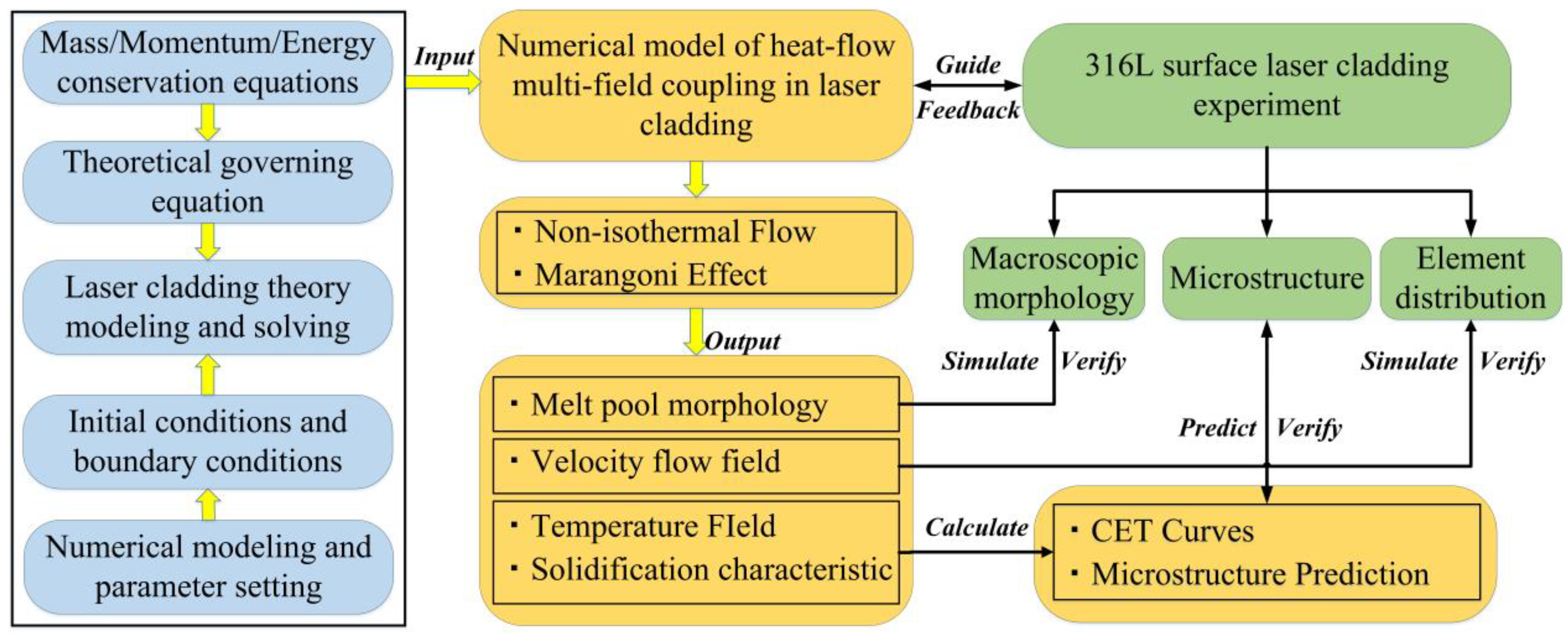



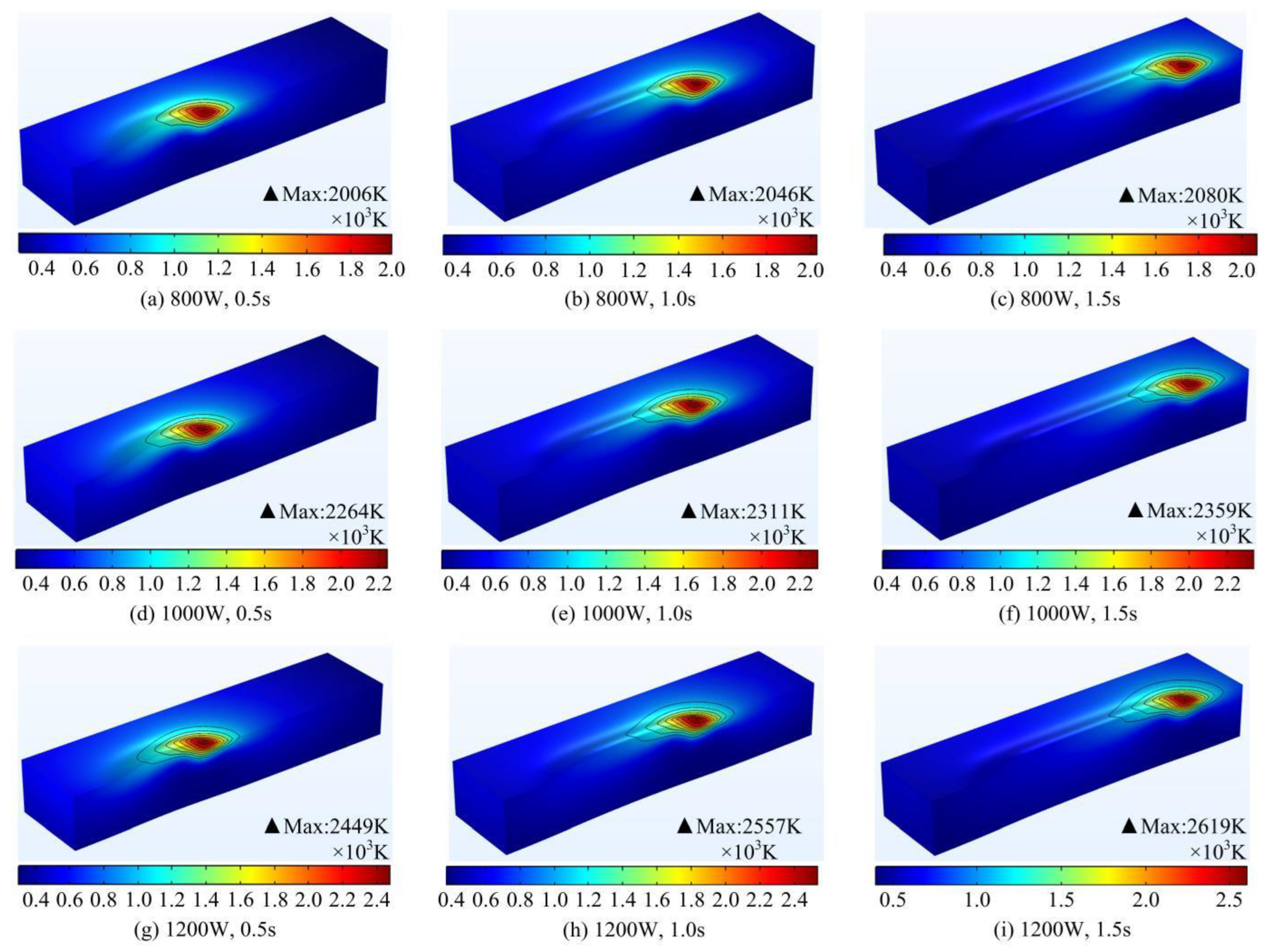
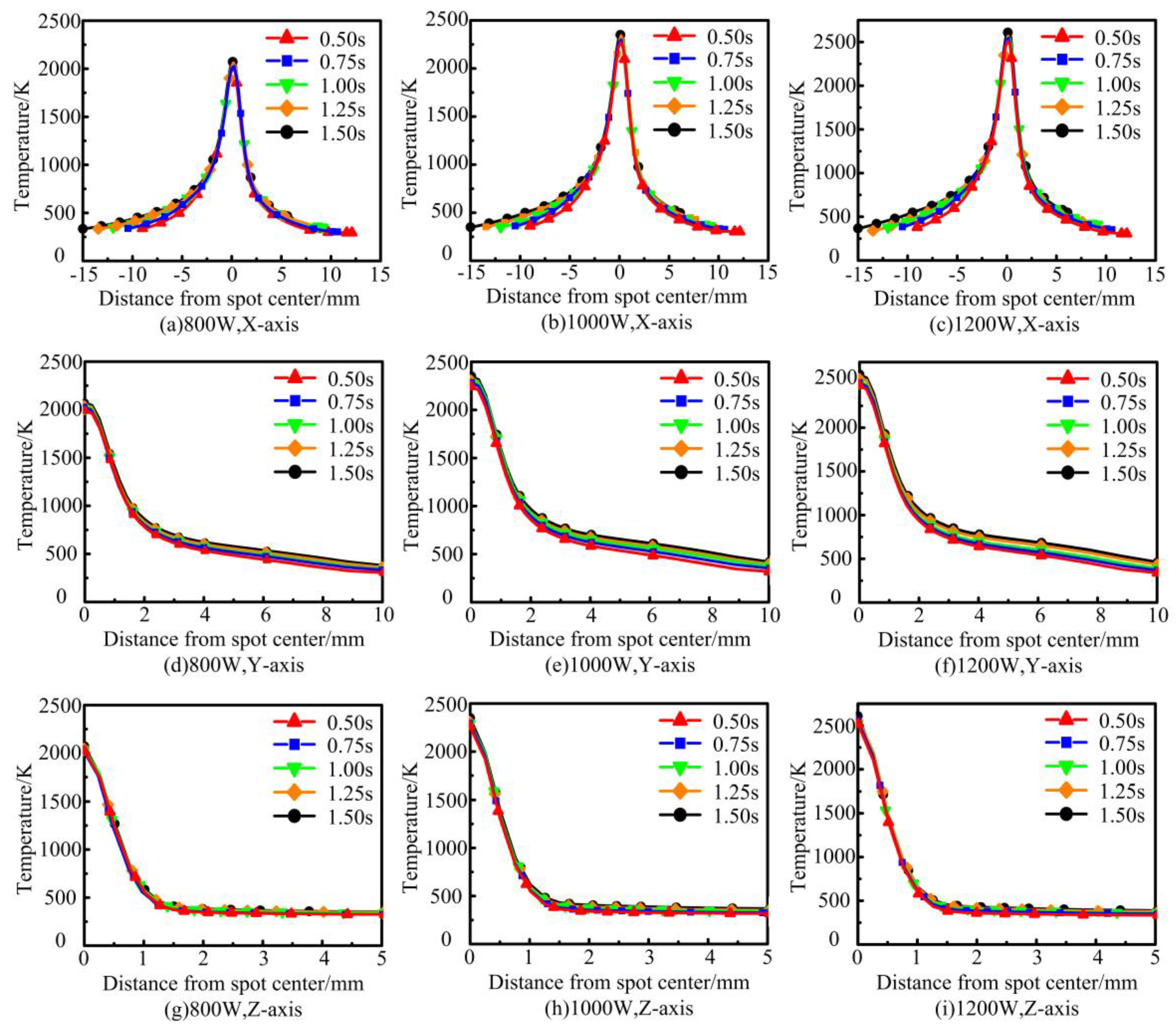

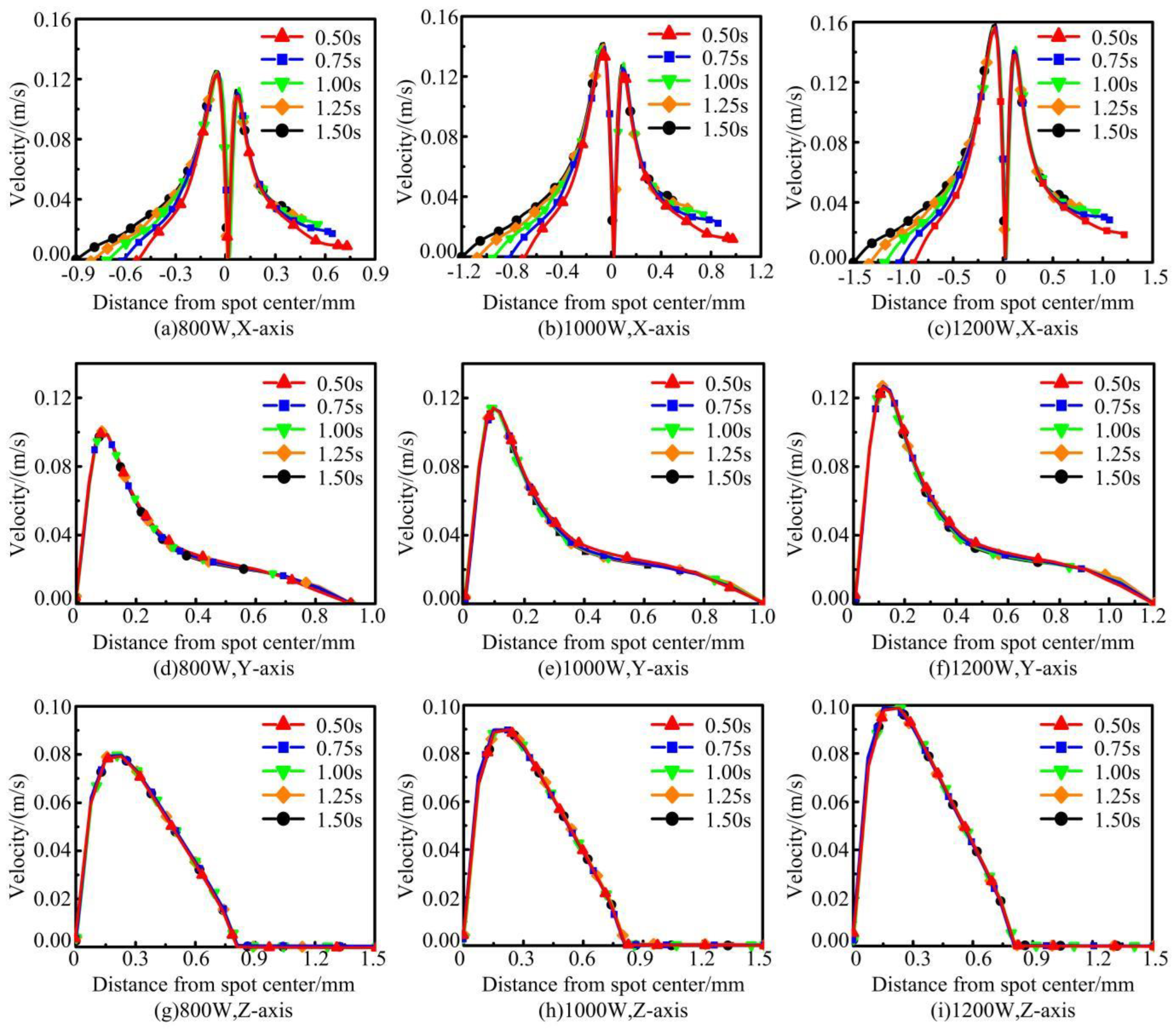
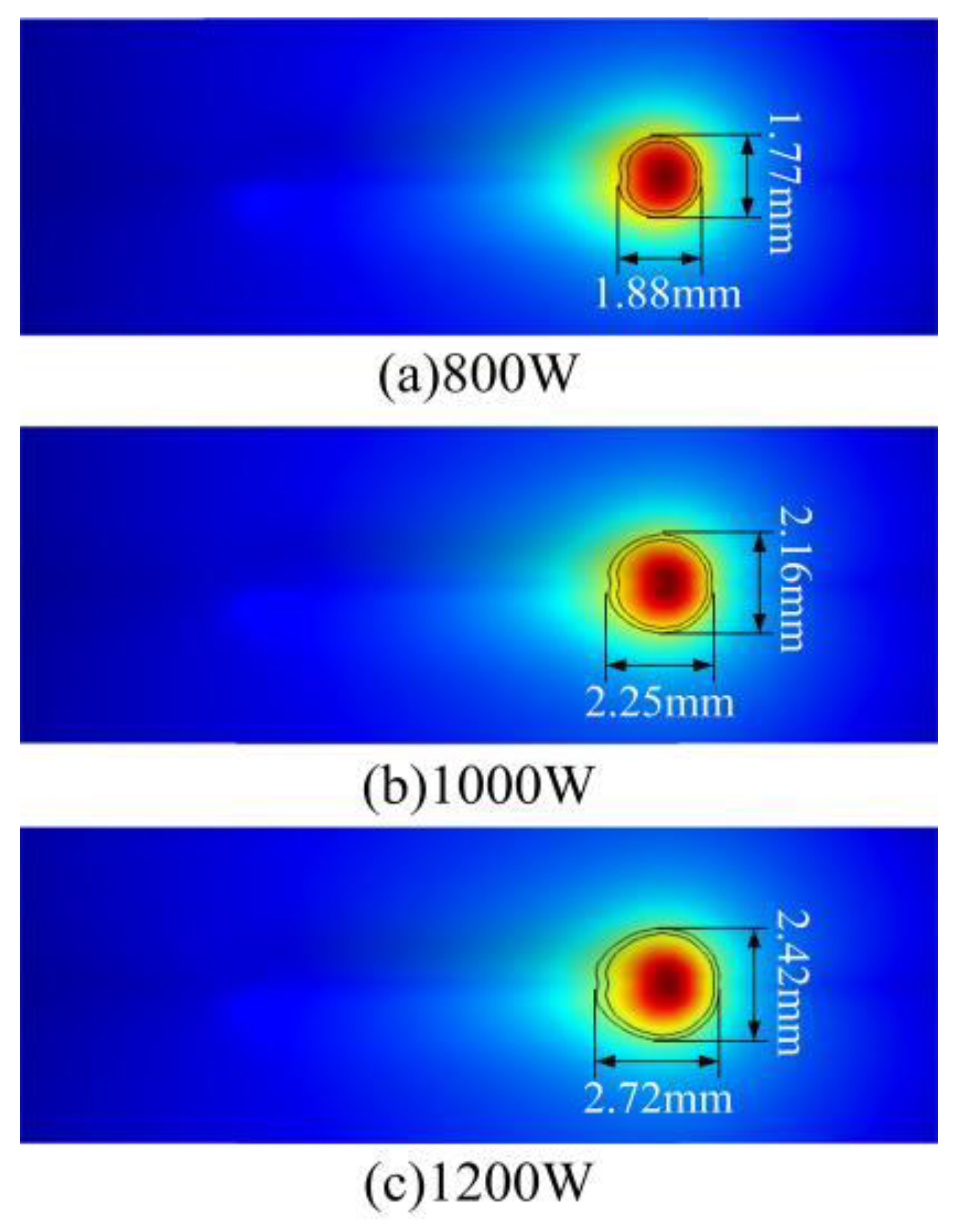
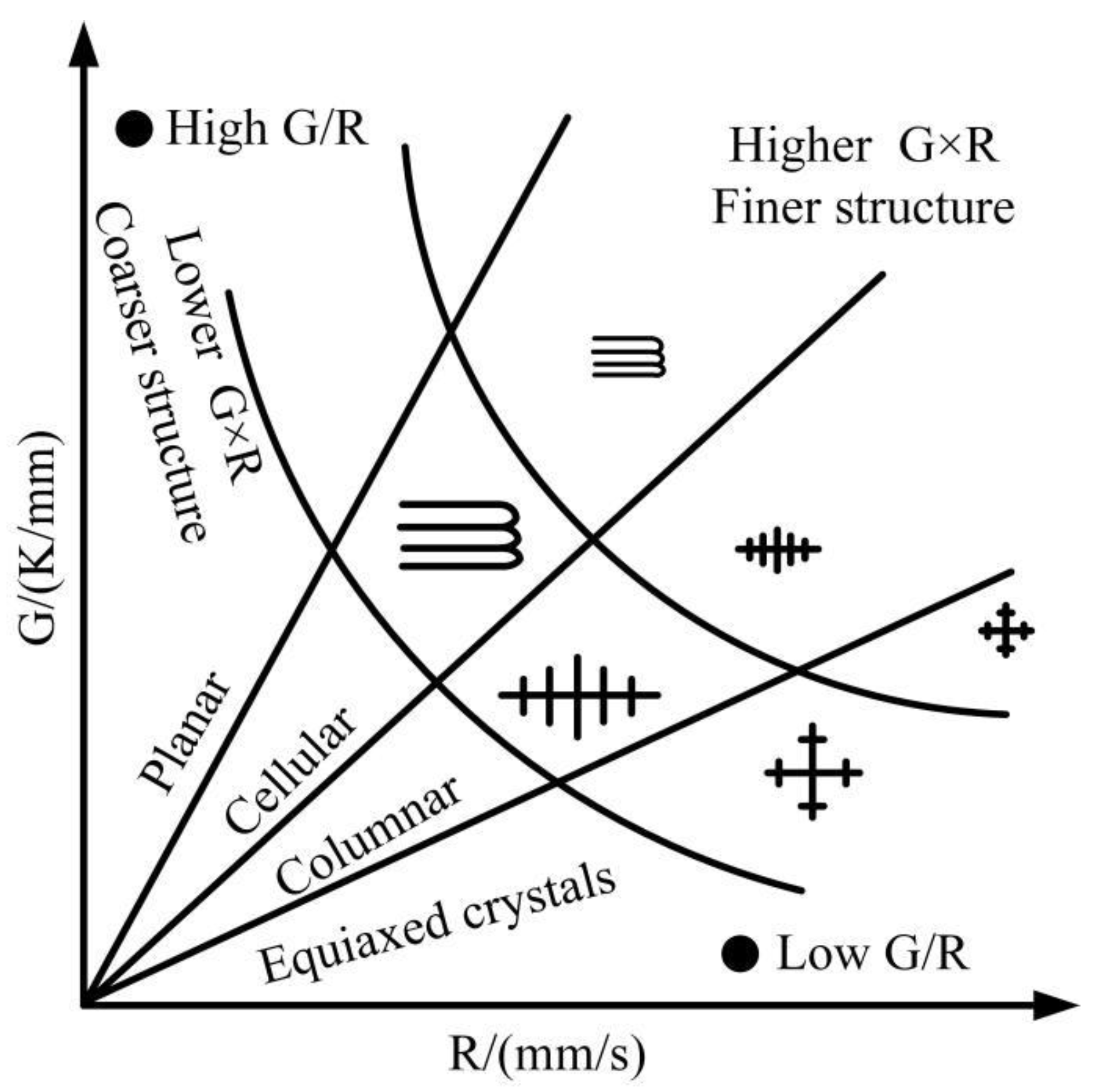


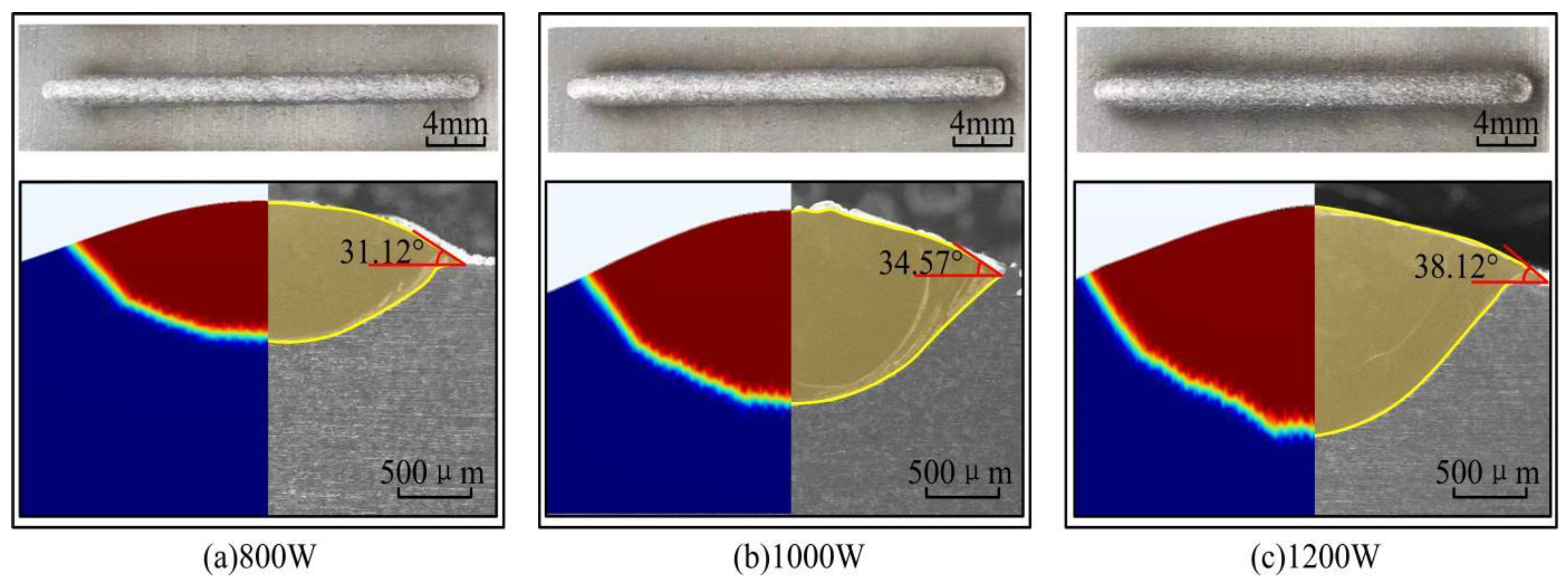
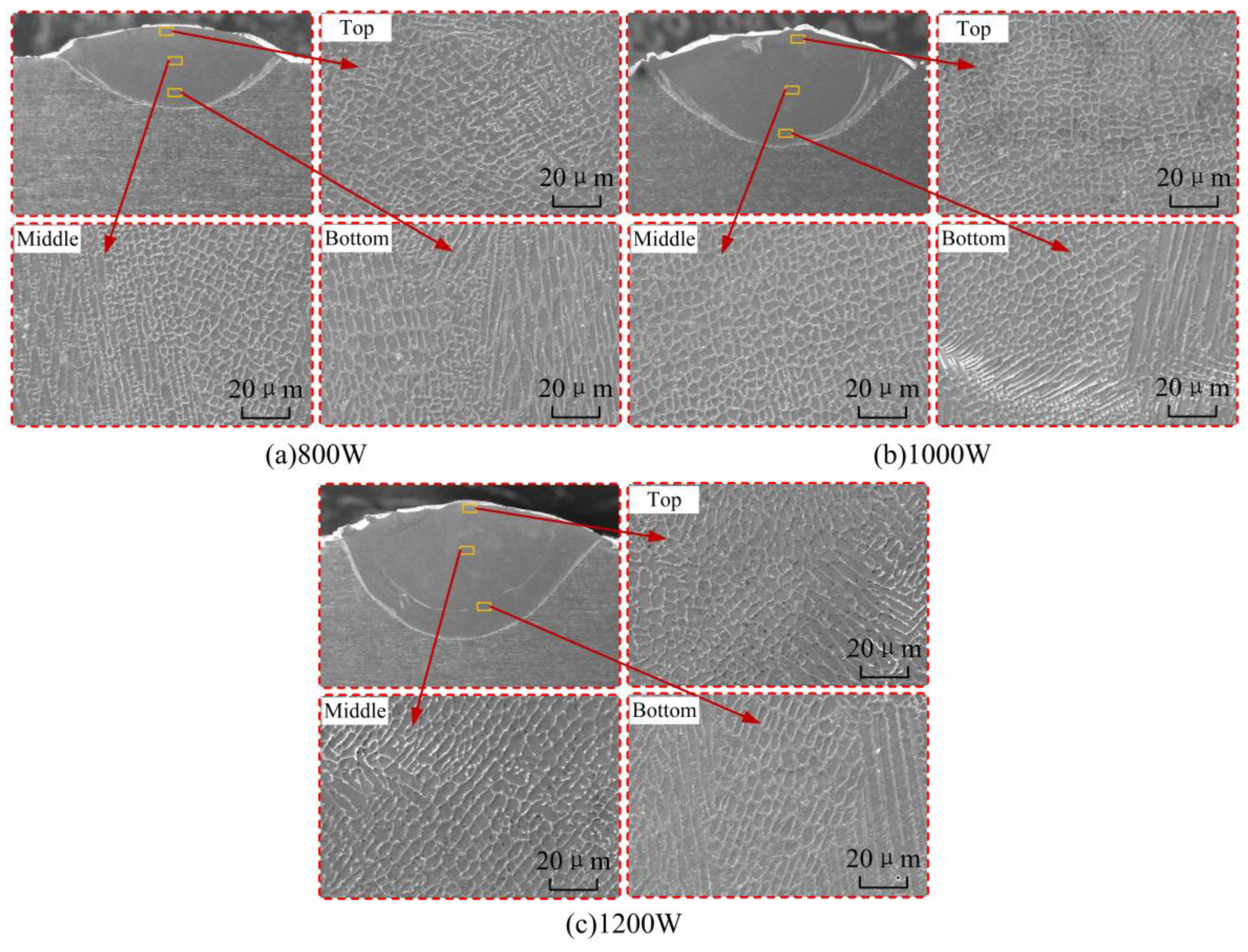
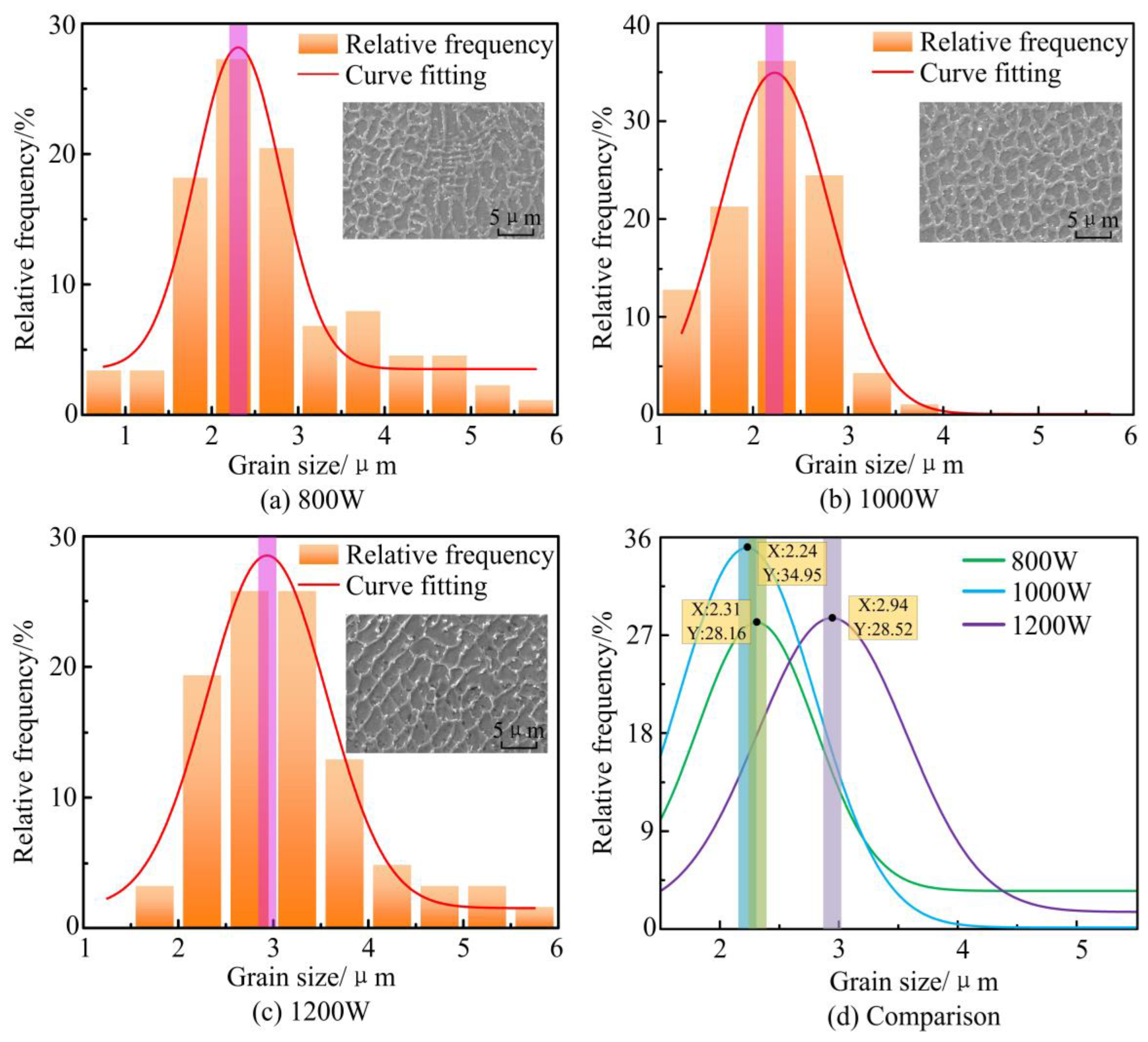
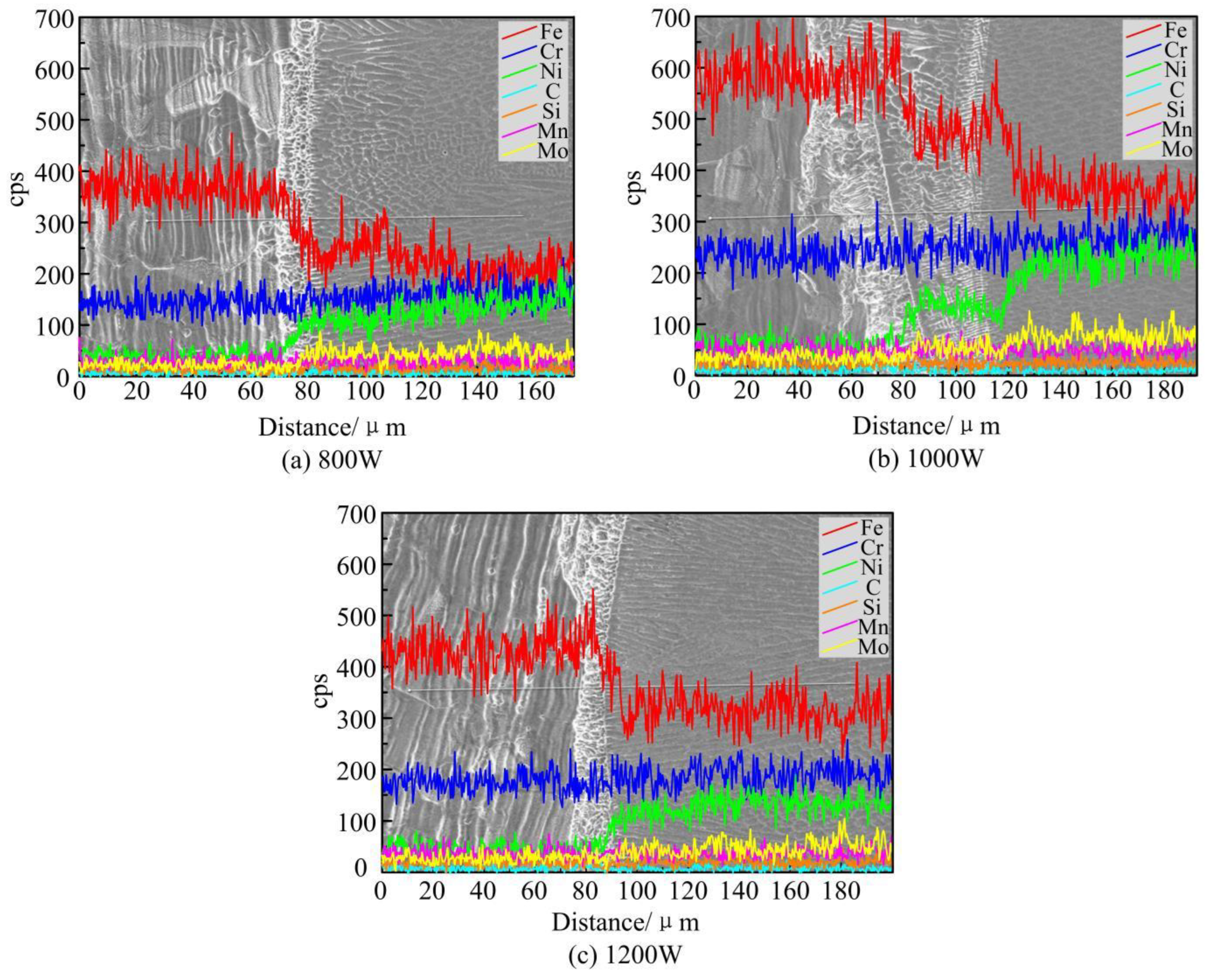
| Fe | C | Si | Mn | P | S | Cr | Ni | Mo | N | Cu | |
|---|---|---|---|---|---|---|---|---|---|---|---|
| 316L stainless steel | 68.7245 | 0.0179 | 0.6 | 1.372 | 0.0266 | 0.019 | 16.88 | 10.05 | 2.01 | 0.3 | / |
| Incoloy 926 alloy | 45.21 | 0.02 | 0.50 | 1.02 | 0.03 | / | 20.00 | 25.5 | 6.50 | 0.25 | 0.96 |
| Process Parameter | Symbol | Value | Unit |
|---|---|---|---|
| Laser Power | PL | 800 | W |
| 1000 | W | ||
| 1200 | W | ||
| Scanning Speed | v | 6 | mm/s |
| Powder Feeding Capacity | vp | 1.6 | r/min |
| Defocusing amount | d | 16 | mm |
| Spot Radius | RL | 1 | mm |
| Melting Radius | r | 1.5 | mm |
| Effective Cladding Depth | h | 1 | mm |
| H/μm | h/μm | W/μm | D (%) | Θ (°) | |
|---|---|---|---|---|---|
| 800 W | 265.80 | 415.08 | 1909.12 | 60.96 | 31.12 |
| 1000 W | 374.57 | 604.49 | 2407.41 | 61.74 | 34.57 |
| 1200 W | 429.84 | 723.53 | 2488.46 | 62.73 | 38.12 |
Disclaimer/Publisher’s Note: The statements, opinions and data contained in all publications are solely those of the individual author(s) and contributor(s) and not of MDPI and/or the editor(s). MDPI and/or the editor(s) disclaim responsibility for any injury to people or property resulting from any ideas, methods, instructions or products referred to in the content. |
© 2024 by the authors. Licensee MDPI, Basel, Switzerland. This article is an open access article distributed under the terms and conditions of the Creative Commons Attribution (CC BY) license (https://creativecommons.org/licenses/by/4.0/).
Share and Cite
Li, L.; Cui, Q.; Zhou, J.; Lu, Z.; Sun, H.; Jiang, H.; Guo, W.; Wu, A. Study on the Influence of Laser Power on the Heat–Flow Multi-Field Coupling of Laser Cladding Incoloy 926 on Stainless Steel Surface. Materials 2024, 17, 4769. https://doi.org/10.3390/ma17194769
Li L, Cui Q, Zhou J, Lu Z, Sun H, Jiang H, Guo W, Wu A. Study on the Influence of Laser Power on the Heat–Flow Multi-Field Coupling of Laser Cladding Incoloy 926 on Stainless Steel Surface. Materials. 2024; 17(19):4769. https://doi.org/10.3390/ma17194769
Chicago/Turabian StyleLi, Linjie, Quanwei Cui, Jianxing Zhou, Zhicheng Lu, Haoran Sun, Hong Jiang, Wanli Guo, and An Wu. 2024. "Study on the Influence of Laser Power on the Heat–Flow Multi-Field Coupling of Laser Cladding Incoloy 926 on Stainless Steel Surface" Materials 17, no. 19: 4769. https://doi.org/10.3390/ma17194769






